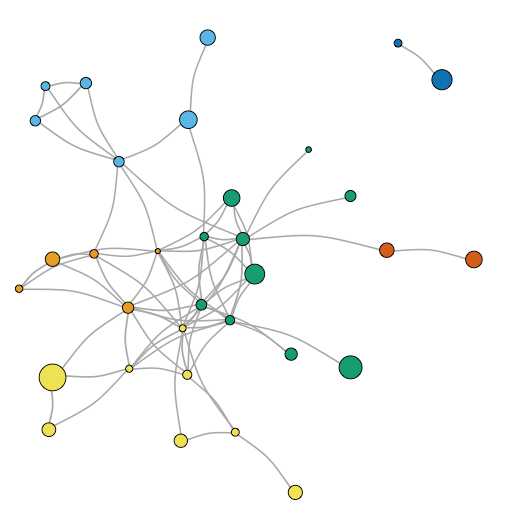Literature review
AC1. Paper Session 1
April 2024

Welcome to ac1!
Dr. Clémentine Cottineau
Assistant Prof. Urban Studies - Urbanism, BK
Urban and economic geography
(systematic) Literature reviews
Together:
- 4 paper sessions for feedback
- peer reviews and presentations
- 1st May: my feedback / other instructor
Hybrid: we speak English, you write in Dutch

What is it & What for?

What is it & What for?
"A literature review is an account of what has been published on a topic by established scientists. The publications should be in accredited sources such as journal and conference papers. The review should convey the knowledge and ideas that have been established on the topic and also what their strength and weaknesses are."
(Silyn-Roberts, 2013, p. 63)
Silyn-Roberts, H. (2013). 4- A literature Review. In H. Silyn-Roberts (Ed.), Writing for science and engineering (Second Edition) (pp. 63-73). DOI:10.1016/B978-0-08-098285-4.00004-2

What is it & What for?
"A literature review is an account of what has been published on a topic by established scientists. The publications should be in accredited sources such as journal and conference papers. The review should convey the knowledge and ideas that have been established on the topic and also what their strength and weaknesses are."
(Silyn-Roberts, 2013, p. 63)
Silyn-Roberts, H. (2013). 4- A literature Review. In H. Silyn-Roberts (Ed.), Writing for science and engineering (Second Edition) (pp. 63-73). DOI:10.1016/B978-0-08-098285-4.00004-2
"Let's not reinvent the wheel!"

What is it & What for?
"A literature review is an account of what has been published on a topic by established scientists. The publications should be in accredited sources such as journal and conference papers. The review should convey the knowledge and ideas that have been established on the topic and also what their strength and weaknesses are."
(Silyn-Roberts, 2013, p. 63)
Silyn-Roberts, H. (2013). 4- A literature Review. In H. Silyn-Roberts (Ed.), Writing for science and engineering (Second Edition) (pp. 63-73). DOI:10.1016/B978-0-08-098285-4.00004-2
- No case study
- No fieldwork
- No interviews

What is it & What for?
It is an answer to a defined question.
> previous contributions, ideas, methods and correlations are presented as facts, in context.
It relies on verified scientific information.
> assess the types and quality of your sources of information
It attributes ideas and contributions properly to their authors (≠ plagiarism)
> citation of publications
It does so in a critical way.

How to:
Find/define/refine your question.
> This will determine the relevant keywords to search, what literature to include/exclude.
Look for verified scientific information.
> assess the types and quality of your sources of information, keep track of your progress
Attribute ideas and contributions properly, discuss their strengths and weaknesses
> citation of publications/maps/figures, plagiarism, chatGPT
https://tedfrick.sitehost.iu.edu/plagiarism/item1.html
The topic
Find the question to answer

SEGREGATION & SOCIAL FRONTIERS
Problem = urban segregation
- separates social groups in space
- reduces social coherence
- creates contextual effects
Consequences: social frontiers
- reflect the fact that segregation separates social groups (≠cohesion)
- points of contacts and exposure
Angle: built environment
How can infrastructure and public space affect social frontiers, facilitate or hinder encounters
EXercise 1 (10min)
EXercise 2 (at home)
The SOURCES
Analyse the sources and assess their scientific value

An example
Look at a 1st page... Are there cues of
- Type of source?
- Author?
- Publication date?
- Publication type?
- Journal?
- Where to find this document?
- How to cite it?
- What is the research question?
- What is the data used?
- What is the main finding?
EXercise 3 (15min)
selecting, READING & Writing
How to review the literature

Selecting
Start by a general source / start article
> to get a general impression of the topic
Pay attention to keywords, authors cited, dates
Search the literature
> systematic search using keywords
> iterative process (// recommendations)
Select the sources
> by type / value of information
> by ability to answer the question

REAding
Step 1.
Look at the titles / authors / keywords / journals / source / type
Step 2.
Read the abstracts to see what you can expect. If abstract seems relevant, skim through (intro, figures, tables, conclusion).
Step 3.
If relevant: read the document and take notes: question, theory, methods, data, case study, findings, limitations, connection to other documents...

Writing
- Expose, discuss and interpret facts
- Use the literature and cite it appropriately
- Combine and compare sources
- Use scientific language
> Be concise and precise (definitions, concepts, dates, theories, etc.)
> use a reference manager (Zotero)
https://www.tudelft.nl/tulib/managing-your-information/reference-management
EXercise 4 (10min)
your paper
Guidelines + tips

Final expectations
- 2000-2500 words (excl. lit. lijst)
- current sources (50% younger than 10y.o.)
- 3 document types (1+ book, 2+ articles, <2 websites)
- following given template (Brightspace)
- addressing the topic of segregation and social frontiers
- using relevant sources from the existing literature
- comparing different viewpoints from different authors on the subject
- giving credits to authors appropriately
- applying what you've learn about academic writing

TIPS:
Read examples of review papers
- about the topic
- from AC1 of past years
Start early and be on time. Especially:
- Next week: Opbouw paper, inleiding, lit. lijst
- mid-may: Conceptpaper.
Use available resources:
- ITAV: vragenuur + schrijfhulp (afspraak)
- Brightspace: lessons, examples, recordings (Collegerama), rubrics, TUwrite videos, etc.
AC1 Paper Session 1
By Clémentine Cottineau
AC1 Paper Session 1
- 894



